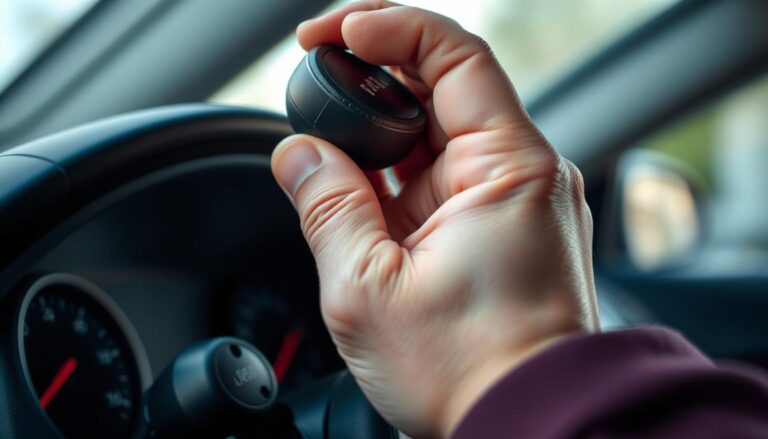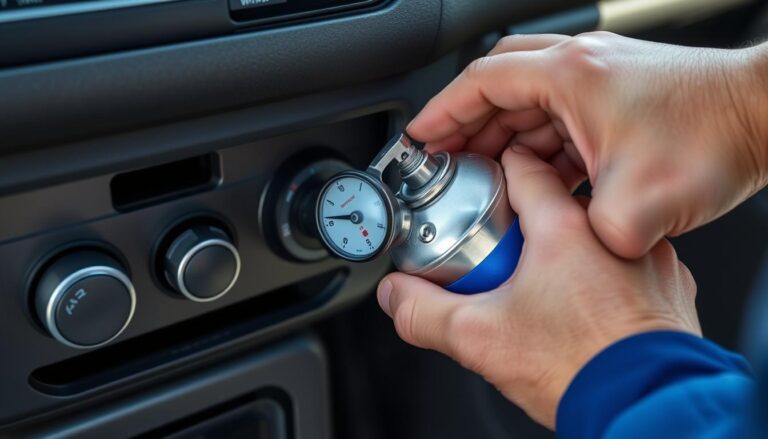Drivers frequently encounter their vehicle emitting a creaking noise when traversing over bumps. This disconcerting sound often heralds underlying issues that necessitate immediate attention. Neglecting such noises can escalate into more critical problems, potentially jeopardizing the vehicle’s safety and operational efficacy.
The suspension system is frequently implicated in creaking noises. Components that are worn out or loose are typically responsible for these sounds. Promptly addressing this issue is imperative to avert further deterioration.
This article aims to guide you through the process of diagnosing and rectifying the creaking noise. We will dissect potential causes, furnish a step-by-step guide for inspecting your vehicle’s suspension, and proffer effective solutions to fix creaking noise.
Key Takeaways
- Identify common causes of car creaking noise
- Understand the importance of addressing suspension issues
- Learn how to inspect your vehicle’s suspension system
- Discover practical solutions to fix creaking noise
- Prevent further damage by taking prompt action
Why Your Car Makes Noise When Driving Over Bumps
The act of traversing over bumps can unveil underlying issues within your vehicle through the manifestation of various noises. It is imperative to heed these auditory cues, as they serve as an early indicator of potential malfunctions. Should these issues remain unaddressed, they could escalate into more critical problems.
The Importance of Addressing Unusual Sounds
Disregarding creaking noises and other unusual sounds can precipitate more severe complications. These auditory signals frequently herald the presence of worn or loose components, which can jeopardize both the safety and operational efficacy of your vehicle. Timely intervention in these matters can avert further deterioration and the resultant financial burden of extensive repairs.
How to Identify Creaking vs. Other Noises
Accurate identification of disparate noises is paramount for effective diagnosis. Creaking noises are typically indicative of worn or dry suspension components. In contrast, clunking or grinding sounds may signal different malfunctions. A meticulous examination and test drive are essential to pinpoint the exact origin of the noise.
| Noise Type | Possible Cause |
|---|---|
| Creaking | Worn or dry suspension components |
| Clunking | Loose or worn-out parts |
| Grinding | Frictional wear on moving parts |

Car Making Creaking Noise When Going Over Bumps: Common Causes
The creaking sound encountered while traversing uneven terrain is not merely an annoyance; it serves as a harbinger of potential malfunctions within the vehicle’s suspension or ancillary systems. Accurate identification of the underlying cause is paramount for efficacious rectification.
Suspension System Components
The suspension system is frequently implicated in the genesis of creaking noises. Degradation of control arm bushings or sway bar links precipitates these sounds when encountering bumps. Proactive inspection can facilitate the early detection of such issues. For a comprehensive exploration of suspension-related creaking, refer to this resource.
Steering Mechanism Issues
Malfunctions within the steering apparatus, such as deterioration of ball joints or tie rod ends, can also induce creaking. These components necessitate periodic inspection and, where necessary, lubrication or replacement.
Chassis and Body Mount Problems
Creaking noises can also emanate from issues with the vehicle’s chassis and body mounts. Inadequate or deteriorated mounts can lead to the body’s displacement and subsequent creaking over bumps. It is imperative to ensure these mounts are securely fastened and in optimal condition.
Interior Trim and Accessory Movements
In some instances, the creaking noise may not originate from the suspension or steering but rather from loose interior trim or accessories. A thorough examination of the dashboard, doors, and other interior elements for any loose components can aid in pinpointing the source of the creak.
| Component | Common Issues | Recommended Action |
|---|---|---|
| Suspension System | Worn-out control arm bushings, sway bar links | Inspect and replace worn components |
| Steering Mechanism | Worn-out ball joints, tie rod ends | Lubricate or replace as necessary |
| Chassis and Body Mounts | Loose or worn-out mounts | Tighten or replace mounts |

Through a methodical examination of these potential sources, vehicle proprietors can pinpoint and rectify the creaking noise, thus enhancing the vehicle’s ride quality and reducing noise levels.
Essential Tools and Materials for Diagnosing Creaking Noises
Diagnosing creaking noises necessitates a collection of indispensable tools and materials, pivotal in pinpointing the root cause of the issue.
Basic Hand Tools for Inspection
An array of fundamental hand tools is imperative for the examination of suspension and steering components. This ensemble includes wrenches, pliers, and screwdrivers. A socket set proves invaluable for accessing areas that are not readily accessible.
Lubricants and Greases
Lubricants and greases are instrumental in both diagnosing and rectifying creaking noises. Silicone spray and white lithium grease are frequently employed to lubricate components with moving parts.
Safety Equipment for Underbody Work
Engaging in underbody work necessitates the utilization of safety equipment. This includes jack stands and safety glasses, designed to safeguard against potential injuries.
| Tool/Material | Description | Use |
|---|---|---|
| Wrenches | Adjustable and fixed wrenches | Loosening and tightening bolts |
| Silicone Spray | Lubricant for moving parts | Reducing friction and creaking |
| Jack Stands | Safety support for vehicles | Ensuring safety during underbody work |
How to Diagnose the Source of Creaking Sounds
The resolution of creaking noises hinges on the precise identification of their origin, achievable through a synergy of visual examination and test drives. This diagnostic endeavor necessitates a methodical strategy to uncover the fundamental cause.
Visual Inspection Techniques
The initial step in diagnosing creaking sounds involves a meticulous visual inspection. It is imperative to scrutinize suspension components for signs of wear, such as control arm bushings and sway bar links. One must also inspect for any loose or damaged parts and assess the state of the vehicle’s undercarriage.
Test Drive Methods to Isolate Noises
A test drive is indispensable for replicating the creaking noise and discerning its characteristics. It is crucial to navigate over diverse terrain and observe when the noise manifests. This approach aids in determining whether the noise emanates from the suspension, steering, or another component.
Using a Helper for More Accurate Diagnosis
Engaging a helper during the diagnostic process can significantly enhance the accuracy of the findings. They can concurrently listen for the noise while you maneuver over bumps, offering invaluable insights into the sound’s origin.
When to Use Diagnostic Equipment
In instances where the creaking noise’s source remains elusive through visual inspection and test drives, the deployment of diagnostic equipment becomes imperative. This is notably true for intricate issues that defy straightforward identification.
| Diagnostic Method | Description | Usefulness |
|---|---|---|
| Visual Inspection | Inspecting vehicle components for wear or damage | High |
| Test Drive | Replicating the noise to understand its characteristics | High |
| Helper-Assisted Diagnosis | Using an additional person to help identify the noise source | Moderate |
| Diagnostic Equipment | Using specialized tools for precise diagnosis | Low to High (depending on the complexity of the issue) |
Step-by-Step Fixes for Suspension-Related Creaking
Creaking noises emanating from the suspension system necessitate a systematic approach for resolution. The suspension’s integrity is paramount for a vehicle’s ride quality and handling prowess. Such creaking sounds often signal the deterioration or loosening of critical components.
Lubricating Control Arm Bushings
Control arm bushings, when dry or worn, frequently contribute to creaking. Lubricating these bushings is a primary corrective measure. Employ a lubricant of appropriate viscosity, and meticulously apply it to the bushings, ensuring the removal of any surplus to avert dirt entrapment.
Addressing Sway Bar Links and Bushings
Sway bar links and bushings are prevalent culprits behind creaking phenomena. Inspect these elements for signs of wear or dryness. Replacing worn sway bar links and the application of lubrication to the bushings can effectively mitigate the noise. Verify that all connections are securely fastened, precluding any looseness.
Replacing Worn Struts and Shock Absorbers
Struts and shock absorbers, when deteriorated, not only induce creaking but also compromise the vehicle’s stability and safety. Replacing these components with newer models can markedly enhance the vehicle’s ride quality and eliminate creaking noises.
Tightening Loose Suspension Components
Loose fasteners or mounts within the suspension system can also precipitate creaking. Conduct a thorough examination of all suspension components and tighten any loose parts. This action can frequently rectify the issue without necessitating more extensive repairs.
| Component | Common Issue | Fix |
|---|---|---|
| Control Arm Bushings | Dryness or Wear | Lubrication |
| Sway Bar Links and Bushings | Wear or Dryness | Replacement and Lubrication |
| Struts and Shock Absorbers | Wear | Replacement |
Adopting these methodologies enables the effective diagnosis and rectification of suspension-related creaking noises, thus enhancing your vehicle’s comfort and safety. Regular maintenance, encompassing the lubrication of bushings and the inspection of suspension components, can avert such maladies in the future.
Resolving Steering and Chassis Creaking Problems
The identification and rectification of creaking sounds emanating from the steering and chassis are paramount for a seamless driving experience. Such noises often herald underlying issues, which, if neglected, could escalate into more critical malfunctions.
Ball Joint Inspection and Maintenance
Ball joints are indispensable to the functionality of the steering and suspension systems. A diligent inspection for signs of deterioration is imperative. Lubrication serves as a preservative measure, yet, when ball joints exhibit wear, their replacement becomes imperative to avert further deterioration.
Tie Rod End Lubrication and Replacement
Tie rod ends, another pivotal component, can generate creaking if not adequately maintained. Regular lubrication mitigates friction and delays wear. Yet, if the tie rod ends are compromised, their replacement is obligatory for the preservation of safe and unimpeded steering.
Body Mount and Subframe Bolt Tightening
Loose body mounts and subframe bolts are common culprits of creaking. It is crucial to verify and tighten these bolts with regularity. Proper tightening not only eradicates creaking but also fortifies the vehicle’s structural integrity.
Applying Anti-Seize Compounds to Prevent Future Issues
The application of anti-seize compounds to bolts and metallic components forestalls future creaking maladies. These compounds diminish friction and inhibit corrosion, facilitating the upkeep of your vehicle’s steering and chassis components.
By tackling these potential trouble spots, the incidence of creaking in your vehicle’s steering and chassis can be markedly diminished. This ensures a more tranquil and secure driving experience.
Preventative Maintenance to Avoid Creaking Noises
To maintain your vehicle’s optimal condition and circumvent the annoyance of creaking noises, a regimen of regular maintenance is imperative. Adopting a proactive stance enables the identification and resolution of potential issues prior to their escalation into significant problems.
Regular Suspension Inspection Schedule
The inspection of your vehicle’s suspension system, a critical component, necessitates regular attention. It is advisable to conduct such inspections every 12,000 to 15,000 miles. During these evaluations, scrutinize components such as control arm bushings, sway bar links, and struts for signs of wear.
Proper Lubrication Intervals
Lubrication, a cornerstone of vehicle maintenance, plays a pivotal role in reducing friction between moving parts. This, in turn, minimizes the likelihood of creaking noises. Adherence to recommended lubrication intervals, typically every 6,000 to 8,000 miles, is crucial.
Addressing Minor Issues Before They Worsen
Minor issues, if neglected, can rapidly escalate into major problems, potentially culminating in creaking noises. For example, a loose or worn-out component can increase stress on adjacent parts, resulting in creaks and groans. Regularly inspecting and addressing minor issues can effectively prevent such escalation.
Seasonal Maintenance Considerations
Diverse seasonal conditions can significantly impact your vehicle’s state. Cold weather can cause materials to contract, potentially leading to creaks, while hot weather can cause expansion, also resulting in noises. Adjust your maintenance schedule to account for these seasonal variations.
As a seasoned mechanic once said,
“A well-maintained vehicle is not just about preventing noises; it’s about ensuring safety and prolonging the vehicle’s lifespan.”
Conclusion
Ensuring the integrity of your vehicle’s suspension system is paramount to mitigate creaking noises encountered during traversal over uneven terrains. This necessitates a comprehensive understanding of the underlying causes coupled with the implementation of the corrective measures detailed within this discourse. Such actions guarantee the optimal functionality of your vehicle’s suspension and ancillary components.
Adherence to a regimen of regular suspension inspections, complemented by meticulous lubrication, serves to markedly diminish the occurrence of creaking noises. For those seeking further elucidation on addressing particular issues, such as front differential noise in your Toyota Tacoma, refer to this resource for an in-depth exploration of the subject matter.
Through a commitment to proactive car maintenance, encompassing suspension repair and the rectification of creaking noises, you can anticipate a more refined and tranquil driving experience. This, in turn, contributes to the prolonged longevity of your vehicle.
FAQ
What are the common causes of creaking noises when driving over bumps?
The primary culprits behind such noises include malfunctions within the suspension system, issues with the steering mechanism, and problems with the chassis and body mounts. Interior trim and accessory movements also contribute to these disturbances.
How do I diagnose the source of creaking sounds in my car?
To pinpoint the source, employ visual inspection techniques and conduct test drives to isolate the noises. The assistance of a second individual can significantly enhance the diagnostic accuracy.
What tools and materials are needed to diagnose creaking noises?
The toolkit required encompasses basic hand tools for thorough inspections, lubricants and greases for maintenance, and safety equipment for underbody work.
How can I fix suspension-related creaking noises?
To rectify these issues, lubricate control arm bushings, address sway bar links and bushings, and replace worn-out struts and shock absorbers. Tightening loose suspension components is also essential.
What is the importance of addressing unusual sounds in my car?
It is imperative to address unusual sounds promptly to prevent further damage. This ensures the vehicle’s safety and maintains its performance.
How can I prevent creaking noises from occurring in the future?
To avert such noises, implement regular suspension inspections, adhere to proper lubrication intervals, and address minor issues before they escalate. Seasonal maintenance is also crucial.
Can I use diagnostic equipment to diagnose creaking noises?
Yes, diagnostic equipment can facilitate a more precise diagnosis, proving invaluable when the source of the creaking noise is elusive.
What are some common steering and chassis creaking problems and their solutions?
Common problems include ball joint malfunctions, tie rod end issues, and body mount and subframe bolt loosening. These can be resolved through thorough inspections, lubrication, and tightening of affected components.


